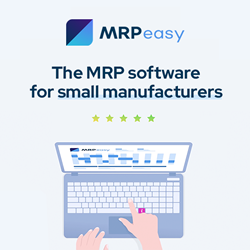Industrial Robots: Encoders for Tool Center Point Accuracy
2018 Predictions for Manufacturing Product & Service Innovation
Improve Part Quality With Multi-axis Welding Positioners
Designing Safe Pneumatic Circuits
APIs for the Modern Factory Floor
The Rise of 5
The Connected Factory
The Future of 3D Printing
Manufacturing Execution Systems (MES) and Accelerating Your Quality System's Actionability
Offline Programming Software is Single Solution for Robotic Hammer Peening of Automotive Stamping Dies
Key Industrial Robotic Trends for 2018
The Skills You Need to Compete in the New World of Manufacturing Engineering
6 Ways Industry 4.0 Is Changing Machine Tools
A Prescription for Trouble
How Additive Manufacturing is Affecting the Industry
Records 1366 to 1380 of 1790
First | Previous | Next | Last
Featured Product

MRPeasy - ERP for Small Manufacturers That Delivers Results
Manufacturing and Automation - Featured Company

